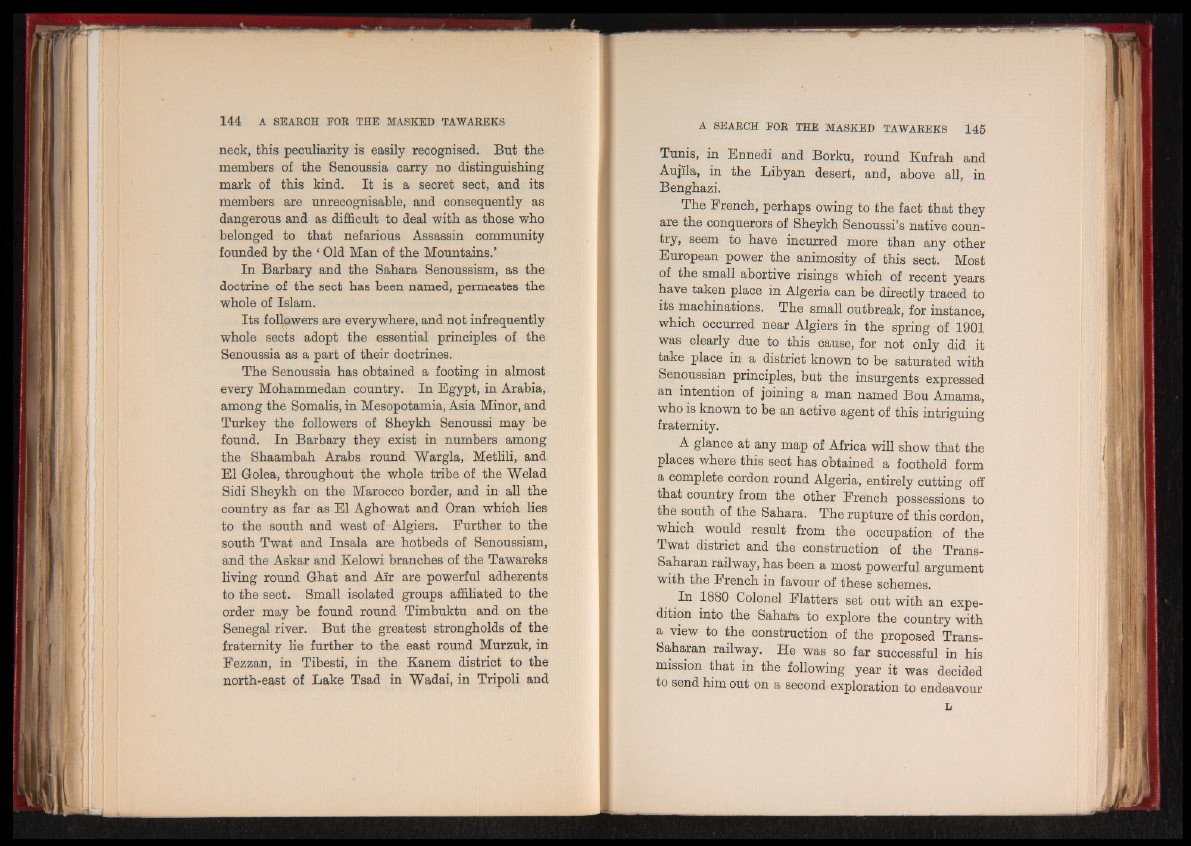
neck, this peculiarity is easily recognised. But the
members of the Senoussia carry no distinguishing
mark of this kind. It is a secret sect, and its
members are unrecognisable, and consequently as
dangerous and as difficult to deal with as those who
belonged to that nefarious Assassin community
founded by the ‘ Old Man of the Mountains.’
In Barbary and the Sahara Senoussism, as the
doctrine of the sect has been named, permeates the
whole of Islam.
Its followers are everywhere, and not infrequently
whole sects adopt the essential principles of the
Senoussia as a part of their doctrines.
The Senoussia has obtained a footing in almost
every Mohammedan country. In Egypt, in Arabia,
among the Somalis, in Mesopotamia, Asia Minor, and
Turkey the followers of Sheykh Senoussi may be
found. In Barbary they exist in numbers among
the Shaambah Arabs round Wargla, Metlili, and
El Golea, throughout the whole tribe of the Welad
Sidi Sheykh on the Marocco border, and in all the
country as far as El Aghowat and Oran which lies
to the south and west of Algiers. Further to the
south Twat and Insala are hotbeds of Senoussism,
and the Askar and Kelowi branches of the Tawareks
living round Ghat and Air are powerful adherents
to the sect. Small isolated groups affiliated to the
order may be found round Timbuktu and on the
Senegal river. But the greatest strongholds of the
fraternity lie further to the east round Murzuk, in
Fezzan, in Tibesti, in the Kanem district to the
north-east of Lake Tsad in Wadai, in Tripoli and
Tunis, in Ennedi and Borku, round Kufrah and
Auj'ila, in the Libyan desert, and, above all, in
Benghazi.
The French, perhaps owing to the fact that they
are the conquerors of Sheykh Senoussi’s native coun-
try, seem to have incurred more than any other
European power the animosity of this sect. Most
of the small abortive risings which of recent years
have taken place in Algeria can be directly traced to
its machinations. The small outbreak, for instance,
which occurred near Algiers in the spring of 1901
was clearly due to this cause, for not only did it
take place in a district known to be saturated with
Senoussian principles, but the insurgents expressed
an intention of joining a man named Bou Amama,
who is known to be an active agent of this intriguing
fraternity.
A glance at any map of Africa will show that the
places where this sect has obtained a foothold form
a complete cordon round Algeria, entirely cutting off
that country from the other French possessions to
the south of the Sahara. The rupture of this cordon,
which would result from the occupation of the
Twat district and the construction of the Trans-
Saharan railway, has been a most powerful argument
with the French in favour of these schemes.
In 1880 Colonel Flatters set out with an expedition
into the Sahara to explore the country with
a view to the construction of the proposed Trans-
Saharan railway. He was so far successful in his
mission that in the following year it was decided
to send him out on a second exploration to endeavour
L